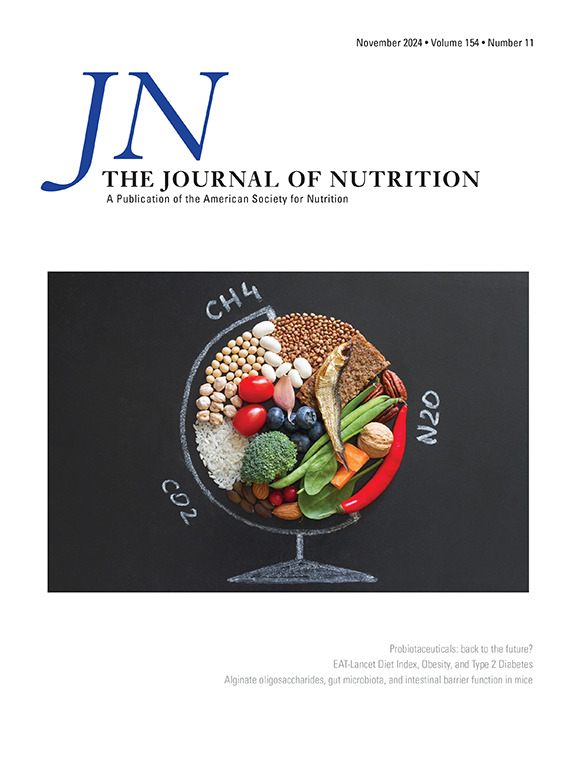食物摄入量与 1 型糖尿病遗传易感性增高儿童的胰岛自身免疫和 1 型糖尿病风险。
IF 3.7
3区 医学
Q2 NUTRITION & DIETETICS
引用次数: 0
摘要
背景:目前还缺乏前瞻性的纵向证据,证明整个儿童时期的食物摄入与胰岛自身免疫(IA或)1型糖尿病的发生有关:我们研究了各种食物的摄入量及其组合与胰岛自身免疫和 1 型糖尿病风险的关系:方法:在前瞻性出生队列 1 型糖尿病预测和预防研究(n=5674)中,对 1996-2004 年出生的具有 1 型糖尿病遗传易感性的儿童进行了从出生到 6 岁的随访。暴露变量包括根据 3 个月至 6 岁期间 3 天重复食物记录得出的 34 种食物组,涵盖整个饮食。终点为胰岛细胞抗体(ICA)加生化IA(人数=247)、多种生化IA(人数=206)和1型糖尿病(人数=94)。我们采用贝叶斯方法分析了纵向观察到的食物与IA/1型糖尿病风险之间的关联,并根据能量摄入、性别、人类白细胞抗原(HLA)基因型和家族性糖尿病调整了单一食物模型和多种食物模型:ICA加生化IA的最终多食物模型包括燕麦[危险比(HR)1.09,95%可信区间(CI)1.04-1.14]、香蕉(HR 1.07,95% CI 1.03-1.11)和十字花科蔬菜(HR 0.83,95% CI 0.73-0.94)。多重生化指标IA的最终模型除上述食物外,还包括发酵乳制品(HR 1.42,95% CI 1.12-1.78)和小麦(HR 1.10,95% CI 1.03-1.18)。1型糖尿病的最终多种食物模型包括黑麦(HR 1.27,95% CI 1.07-1.50)、燕麦(HR 1.15,95% CI 1.03-1.26)、水果(HR 1.05,95% CI 1.01-1.09)和浆果(HR 0.67,95% CI 0.50-0.93):综合考虑所有食物,燕麦、含麸谷物和水果摄入量越高,患 1 型糖尿病相关终点的风险越高;十字花科蔬菜摄入量越高,患 1 型糖尿病相关终点的风险越低。有必要开展进一步的病因和机理研究。本文章由计算机程序翻译,如有差异,请以英文原文为准。
Food Consumption and Risk of Islet Autoimmunity and Type 1 Diabetes in Children at Increased Genetic Susceptibility for Type 1 Diabetes
Background
Prospective longitudinal evidence considering the entire childhood food consumption in relation to the development of islet autoimmunity (IA or) type 1 diabetes is lacking.
Objectives
We studied the associations of consumption of various foods and their combinations with IA and type 1 diabetes risk.
Methods
Children with genetic susceptibility to type 1 diabetes born in 1996–2004 were followed from birth up to ≤6 y of age in the prospective birth cohort type 1 diabetes prediction and prevention study (n = 5674). Exposure variables included 34 food groups covering the entire diet based on repeated 3-d food records at ages 3 mo to 6 y. Endpoints were islet cell antibodies plus biochemical IA (n = 247), multiple biochemical IA (n = 206), and type 1 diabetes (n = 94). We analyzed associations between longitudinally observed foods and risk of IA/type 1 diabetes using a Bayesian approach to joint models in 1-food and multi-food models adjusted for energy intake, sex, human leukocyte antigen genotype, and familial diabetes.
Results
The final multi-food model for islet cell antibodies plus biochemical IA included oats [hazard ratio (HR): 1.09; 95% credible interval (CI): 1.04, 1.14], banana (HR: 1.07; 95% CI: 1.03, 1.11), and cruciferous vegetables (HR: 0.83; 95% CI: 0.73, 0.94). The final model for multiple biochemical IA included, in addition to the above-mentioned foods, fermented dairy (HR: 1.42; 95% CI: 1.12, 1.78) and wheat (HR: 1.10; 95% CI: 1.03, 1.18). The final multi-food model for type 1 diabetes included rye (HR: 1.27; 95% CI: 1.07, 1.50), oats (HR: 1.15; 95% CI: 1.03, 1.26), fruits (HR: 1.05; 95% CI: 1.01, 1.09), and berries (HR: 0.67; 95% CI: 0.50, 0.93).
Conclusions
Higher consumption of oats, gluten-containing cereals, and fruits was associated with increased that of cruciferous vegetables with decreased risk of several type 1 diabetes-related endpoints when considering all the foods in combination. Further etiological and mechanistic studies are warranted.
求助全文
通过发布文献求助,成功后即可免费获取论文全文。
去求助
来源期刊

Journal of Nutrition
医学-营养学
CiteScore
7.60
自引率
4.80%
发文量
260
审稿时长
39 days
期刊介绍:
The Journal of Nutrition (JN/J Nutr) publishes peer-reviewed original research papers covering all aspects of experimental nutrition in humans and other animal species; special articles such as reviews and biographies of prominent nutrition scientists; and issues, opinions, and commentaries on controversial issues in nutrition. Supplements are frequently published to provide extended discussion of topics of special interest.
 求助内容:
求助内容: 应助结果提醒方式:
应助结果提醒方式:


